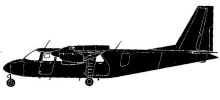
ASN Wikibase Occurrence # 318863
| Date: | Tuesday 15 February 2022 |
| Time: | 09:50 |
| Type: |  Britten-Norman BN-2A-9 Islander |
| Owner/operator: | Air Flamenco |
| Registration: | N821RR |
| MSN: | 338 |
| Year of manufacture: | 1973 |
| Total airframe hrs: | 2871 hours |
| Cycles: | 5773 flights |
| Engine model: | Lycoming O-540-E4C5 |
| Fatalities: | Fatalities: 0 / Occupants: 3 |
| Aircraft damage: | Substantial |
| Category: | Accident |
| Location: | Culebra Airport (CPX) -
 Puerto Rico Puerto Rico
|
| Phase: | Landing |
| Nature: | Training |
| Departure airport: | San Juan-Fernando Luis Ribas Dominicci Airport (SIG/TJIG) |
| Culebra Airport (CPX/TJCP) | |
| Investigating agency: | NTSB |
| Confidence Rating: |
A Britten-Norman BN-2A-9 Islander, registration N821RR, suffered substantial damage in an accident while landing on runway 13 at Culebra Airport (CPX), Puerto Rico.
The airplane was operated as an instructional flight. The pilot had recently retired from flying large category transport airplanes. He was recently hired Air Flamenco and had received some ground school training on the BN-2A-9, the company mission, routes, and destinations. The accident occurred on the first landing of his first flight, and it was his first ever landing at the accident airport. The pilot stated that he entered a left downwind for landing on runway 13, and the estimated winds were 090° at 15 to 16 knots. The approach was flown about 80 knots and about 100 ft above the normal flight path, the stated to the NTSB.
After touchdown the airplane "leaned to the right" and veered off the right side of the runway.
The commercial pilot seated in the back stated it was not a hard landing, but it was "harder than anything he had experienced before at that airport."
The right-hand wing was partially severed at the wing root and the airplane came to a stop in the grass on the left side of the runway. The right propeller blades displayed tip curling and the orange-painted wingtip displayed impact damage and longitudinal scraping and asphalt transfer.
Probable Cause: The flight crews failure to arrest the descent rate during the non-standard approach, which resulted in a hard landing and failure of the right-wing structure. Contributing was the flight instructors selection of a challenging approach for initial training.
Accident investigation:
 |
|
Sources:
FAA
Location
Revision history:
| Date/time | Contributor | Updates |
|---|
The Aviation Safety Network is an exclusive service provided by:


 ©2024 Flight Safety Foundation
©2024 Flight Safety Foundation